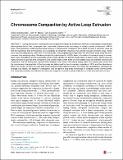| dc.contributor.author | Marko, John F. | |
| dc.contributor.author | Goloborodko, Anton | |
| dc.contributor.author | Mirny, Leonid A | |
| dc.date.accessioned | 2017-12-19T14:32:06Z | |
| dc.date.available | 2017-12-19T14:32:06Z | |
| dc.date.issued | 2016-05 | |
| dc.date.submitted | 2015-09 | |
| dc.identifier.issn | 0006-3495 | |
| dc.identifier.issn | 1542-0086 | |
| dc.identifier.uri | http://hdl.handle.net/1721.1/112797 | |
| dc.description.abstract | During cell division, chromosomes are compacted in length by more than a 100-fold. A wide range of experiments demonstrated that in their compacted state, mammalian chromosomes form arrays of closely stacked consecutive ∼100 kb loops. The mechanism underlying the active process of chromosome compaction into a stack of loops is unknown. Here we test the hypothesis that chromosomes are compacted by enzymatic machines that actively extrude chromatin loops. When such loop-extruding factors (LEF) bind to chromosomes, they p rogressively bridge sites that are further away along the chromosome, thus extruding a loop. We demonstrate that collective action of LEFs leads to formation of a dynamic array of consecutive loops. Simulations and an analytically solved model identify two distinct steady states: a sparse state, where loops are highly dynamic but provide little compaction; and a dense state, where there are more stable loops and dramatic chromosome compaction. We find that human chromosomes operate at the border of the dense steady state. Our analysis also shows how the macroscopic characteristics of the loop array are determined by the microscopic properties of LEFs and their abundance. When the number of LEFs are used that match experimentally based estimates, the model can quantitatively reproduce the average loop length, the degree of compaction, and the general loop-array morphology of compact human chromosomes. Our study demonstrates that efficient chromosome compaction can be achieved solely by an active loop-extrusion process. | en_US |
| dc.description.sponsorship | National Institutes of Health (U.S.) (Grant GM114190) | en_US |
| dc.description.sponsorship | National Institutes of Health (U.S.) (Grant R01HG003143) | en_US |
| dc.publisher | Elsevier | en_US |
| dc.relation.isversionof | http://dx.doi.org/10.1016/J.BPJ.2016.02.041 | en_US |
| dc.rights | Creative Commons Attribution 4.0 International License | en_US |
| dc.rights.uri | http://creativecommons.org/licenses/by/4.0/ | en_US |
| dc.source | Elsevier | en_US |
| dc.title | Chromosome Compaction by Active Loop Extrusion | en_US |
| dc.type | Article | en_US |
| dc.identifier.citation | Goloborodko, Anton et al. “Chromosome Compaction by Active Loop Extrusion.” Biophysical Journal 110, 10 (May 2016): 2162–2168 © 2016 Biophysical Society | en_US |
| dc.contributor.department | Massachusetts Institute of Technology. Institute for Medical Engineering & Science | en_US |
| dc.contributor.department | Massachusetts Institute of Technology. Department of Physics | en_US |
| dc.contributor.mitauthor | Goloborodko, Anton | |
| dc.contributor.mitauthor | Mirny, Leonid A | |
| dc.relation.journal | Biophysical Journal | en_US |
| dc.eprint.version | Final published version | en_US |
| dc.type.uri | http://purl.org/eprint/type/JournalArticle | en_US |
| eprint.status | http://purl.org/eprint/status/PeerReviewed | en_US |
| dc.date.updated | 2017-12-18T20:42:50Z | |
| dspace.orderedauthors | Goloborodko, Anton; Marko, John F.; Mirny, Leonid A. | en_US |
| dspace.embargo.terms | N | en_US |
| dc.identifier.orcid | https://orcid.org/0000-0002-2210-8616 | |
| dc.identifier.orcid | https://orcid.org/0000-0002-0785-5410 | |
| mit.license | PUBLISHER_CC | en_US |
| mit.metadata.status | Complete | |
